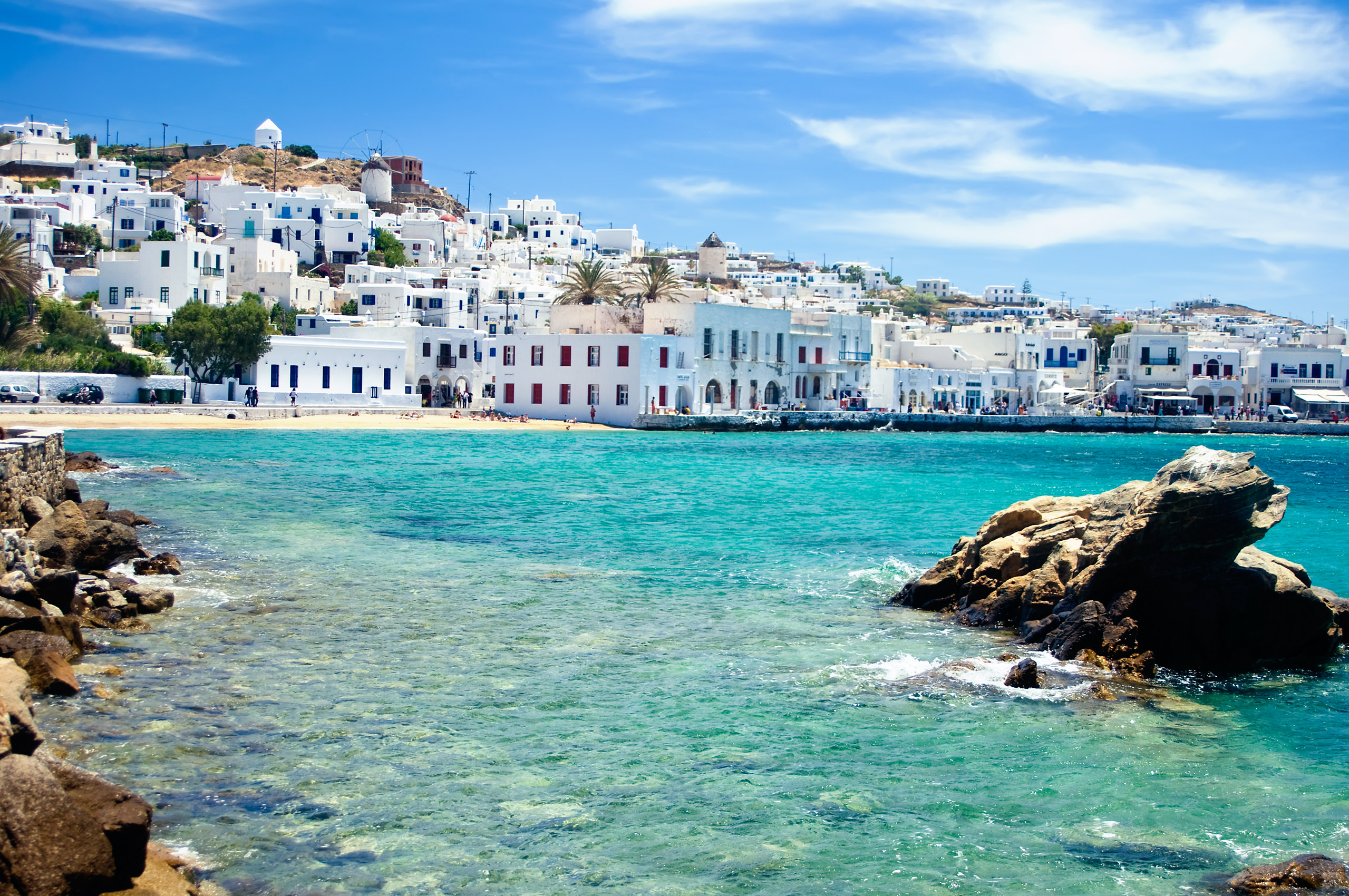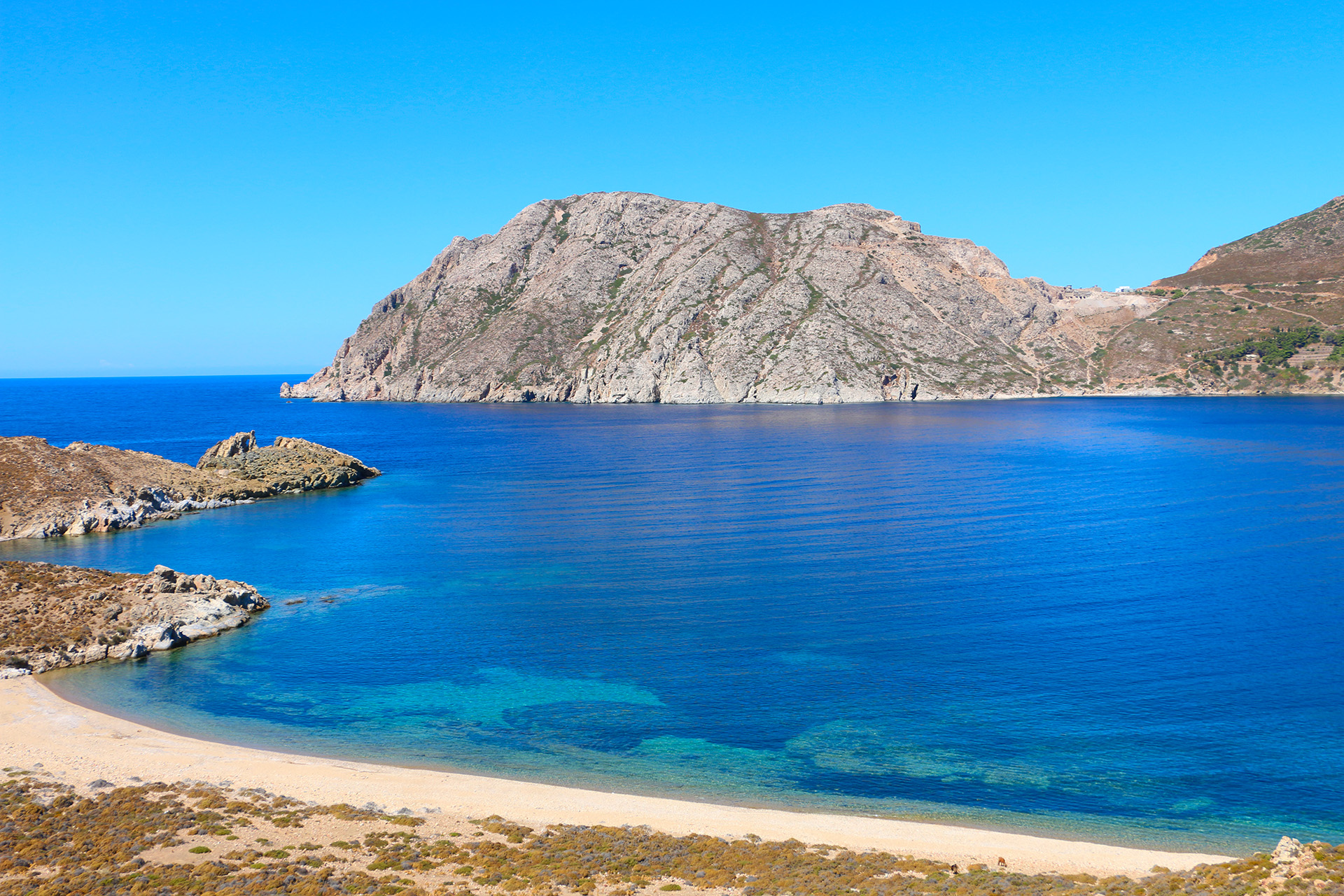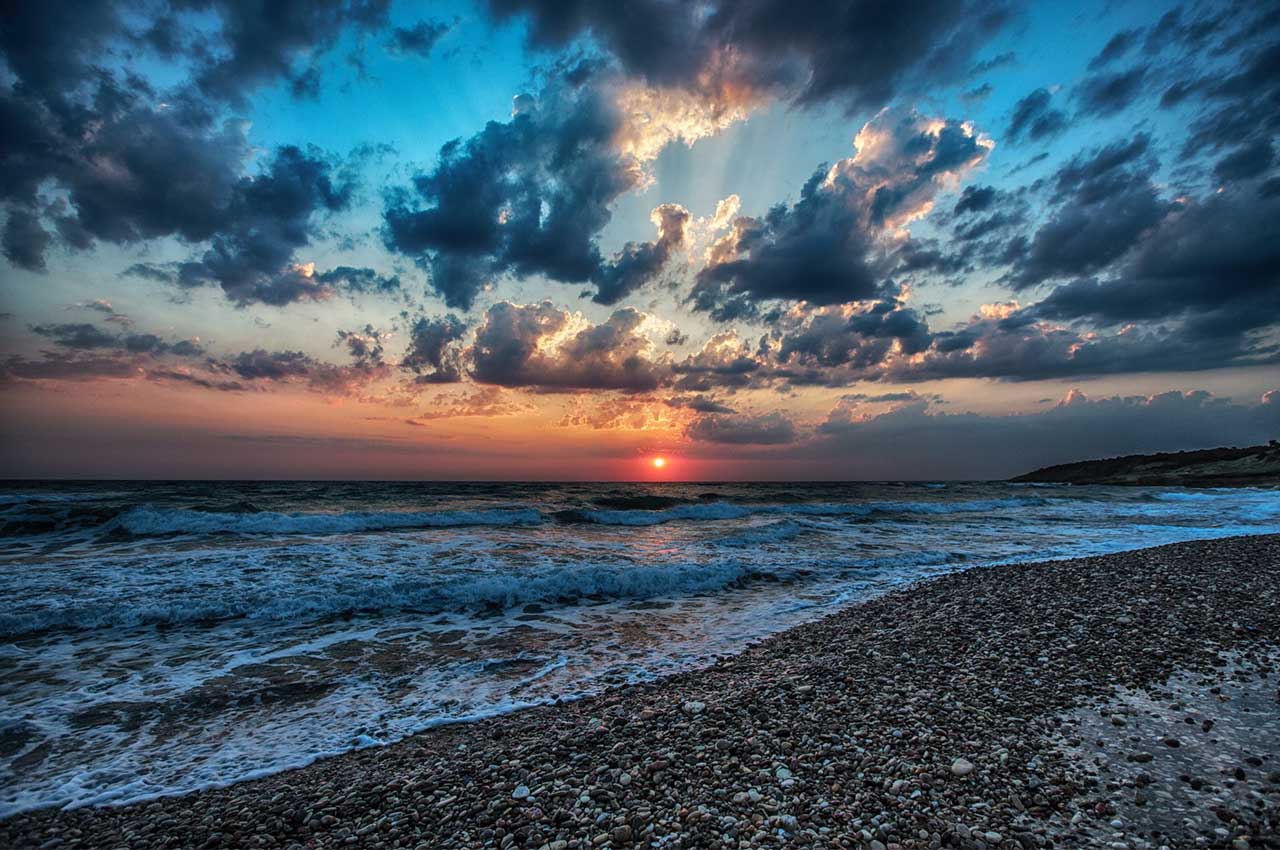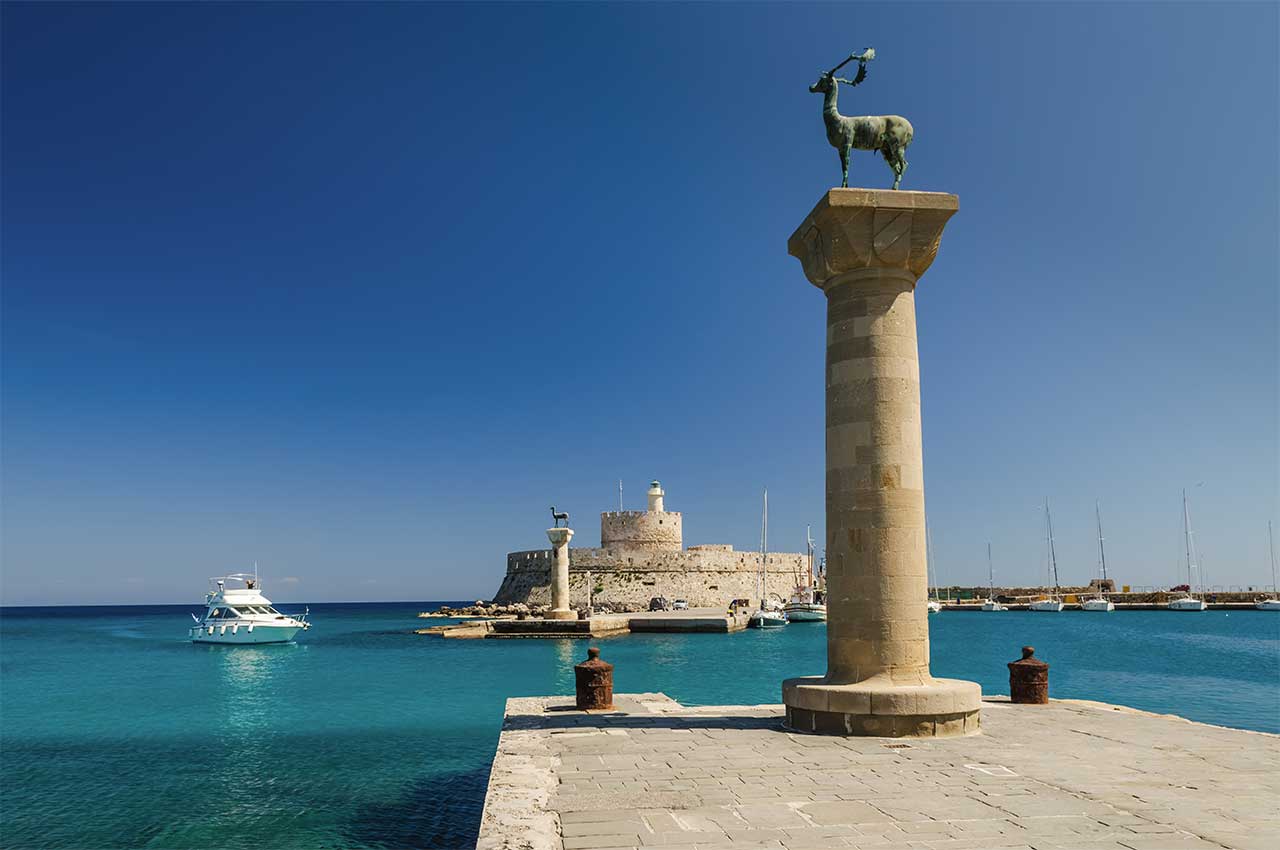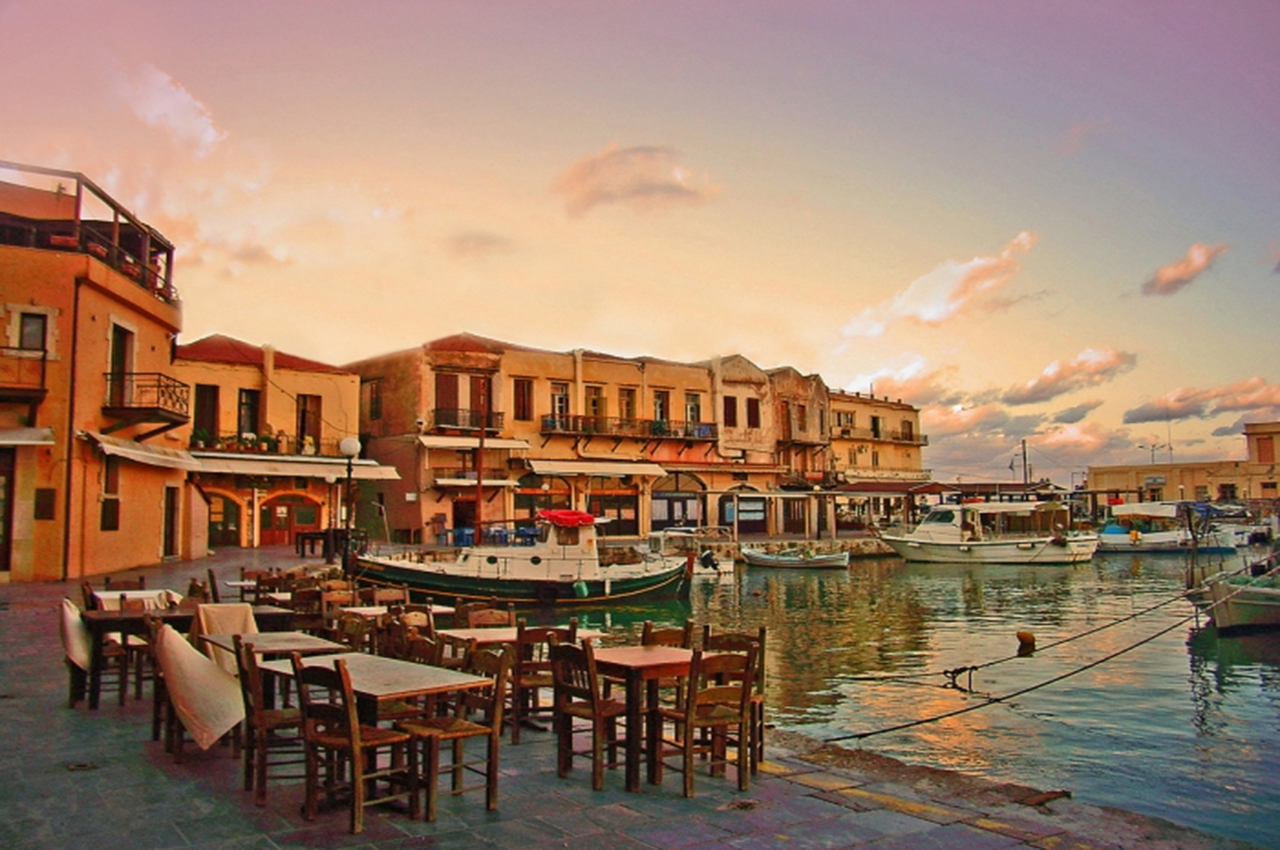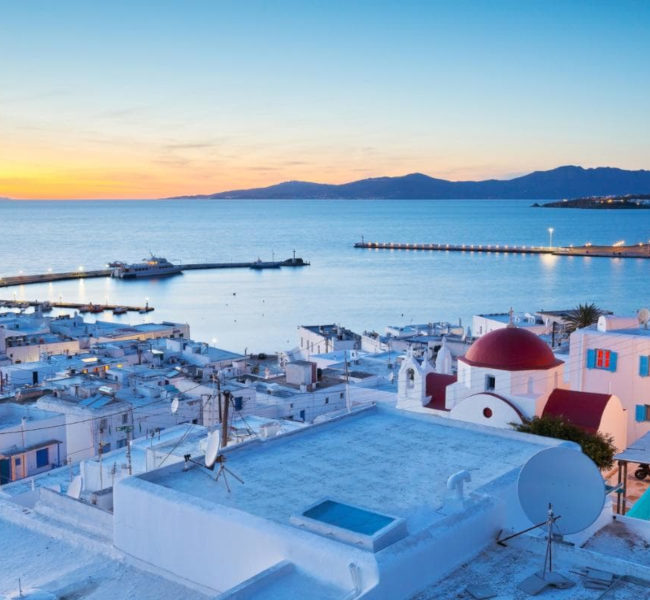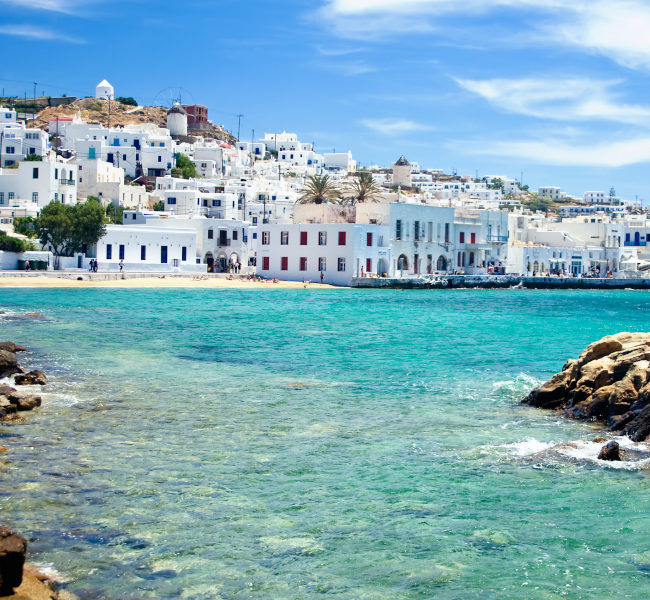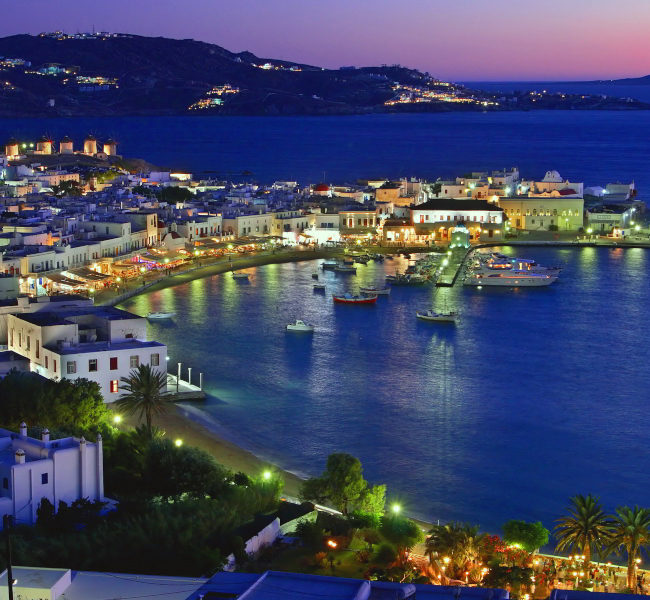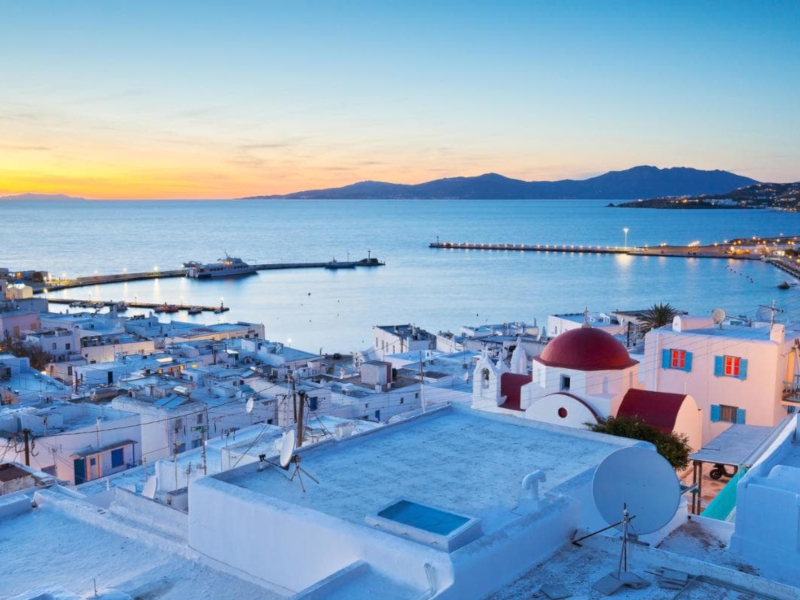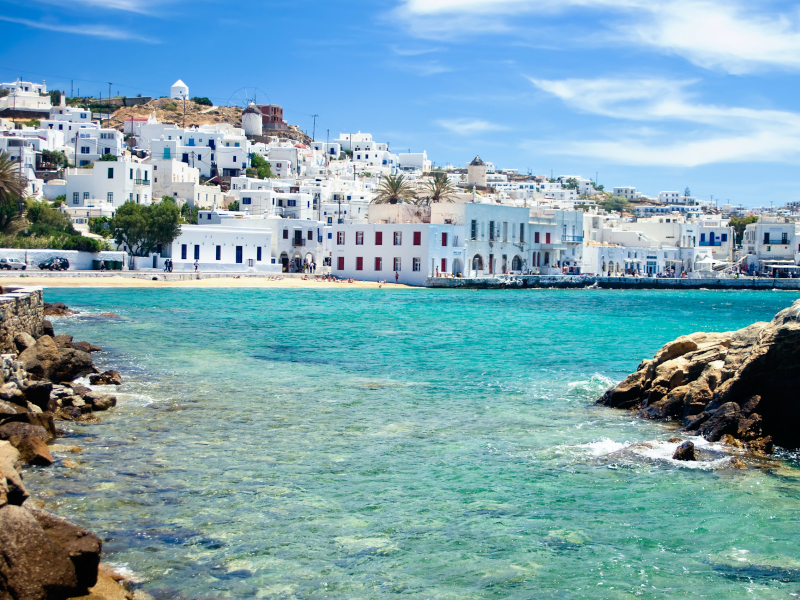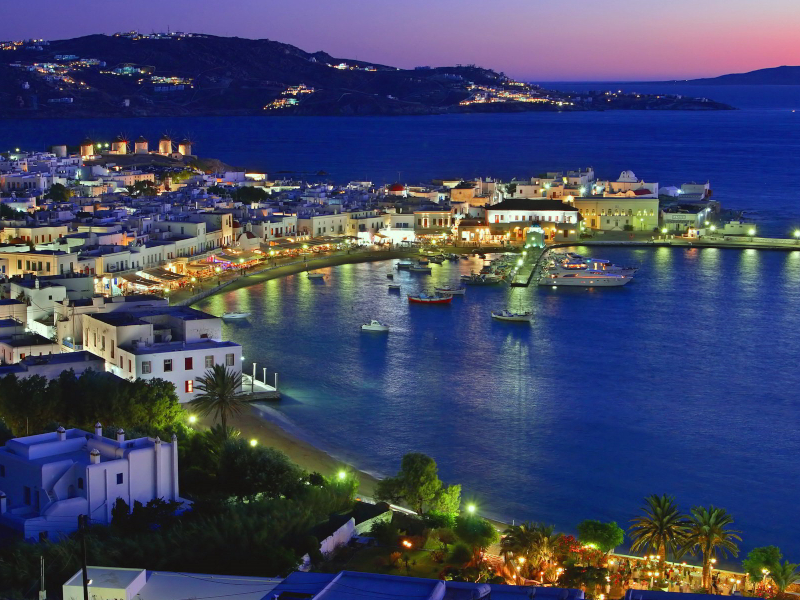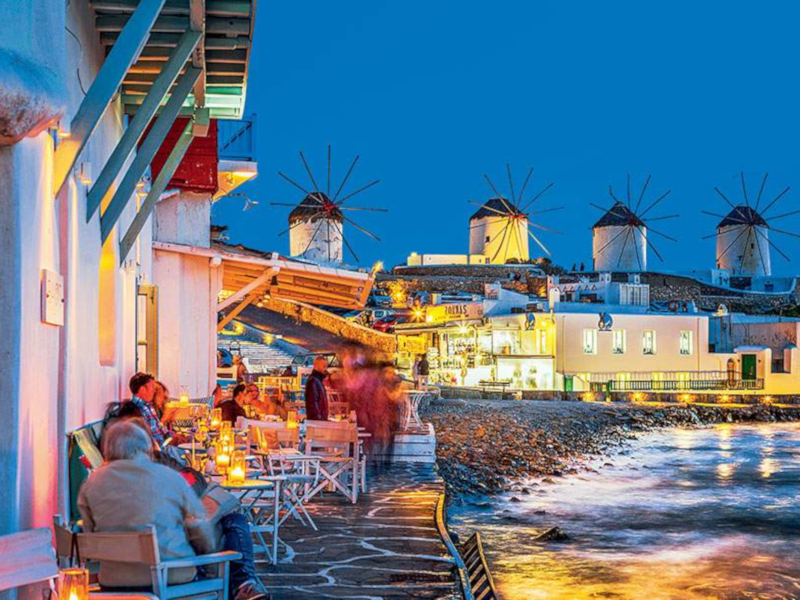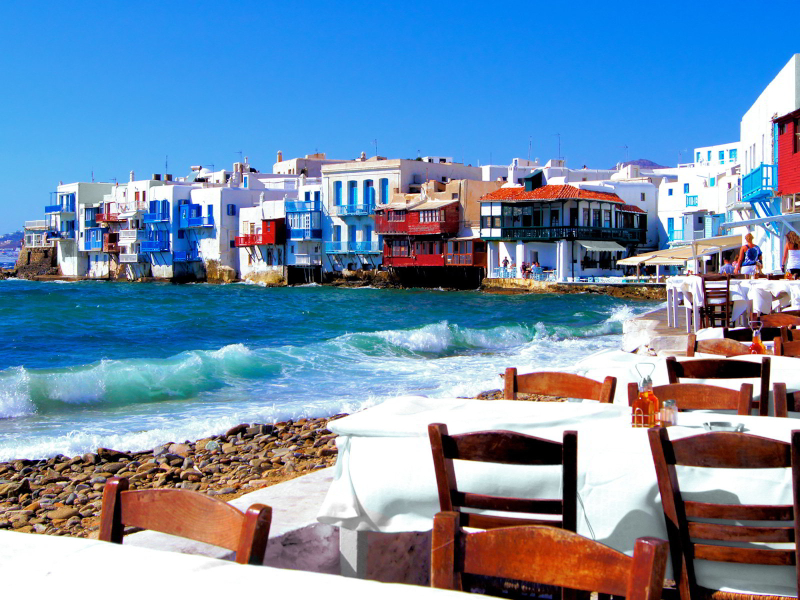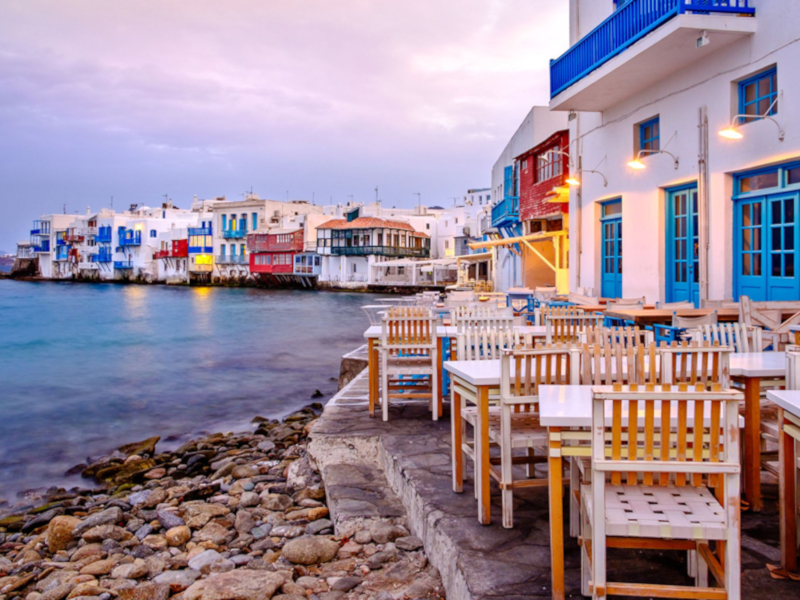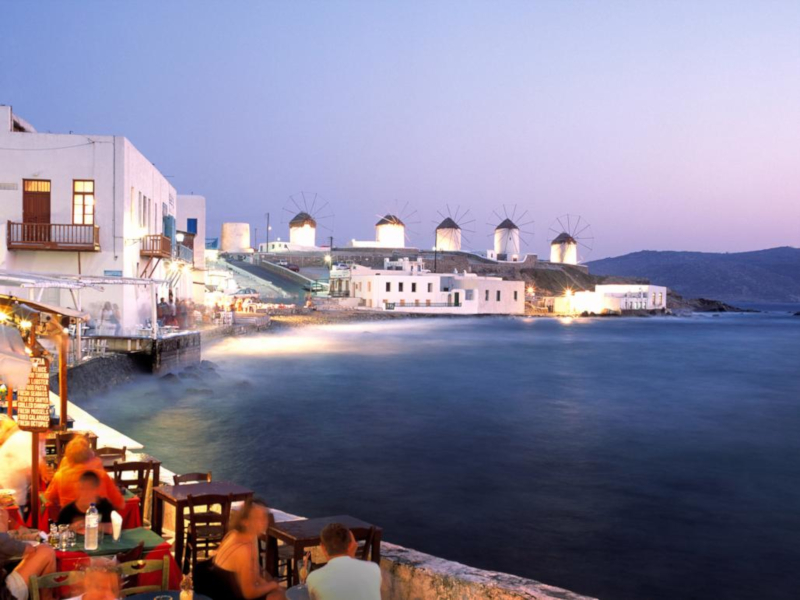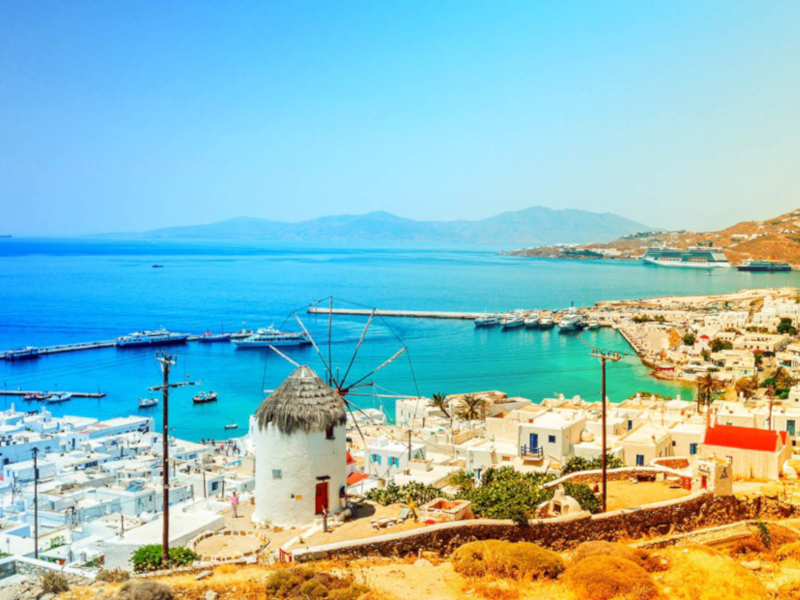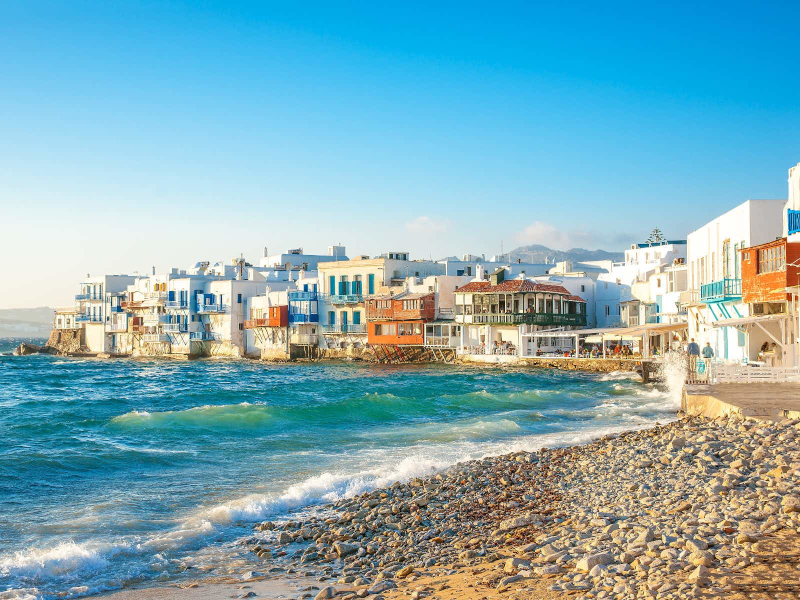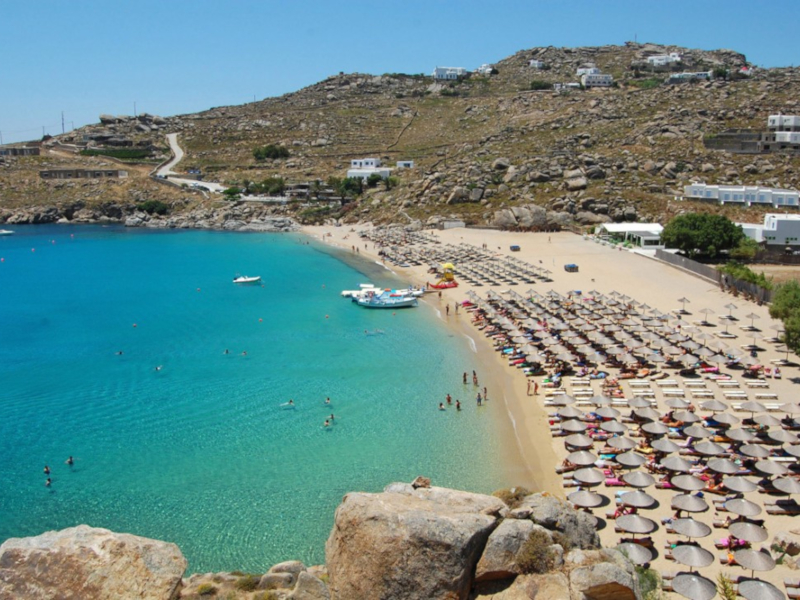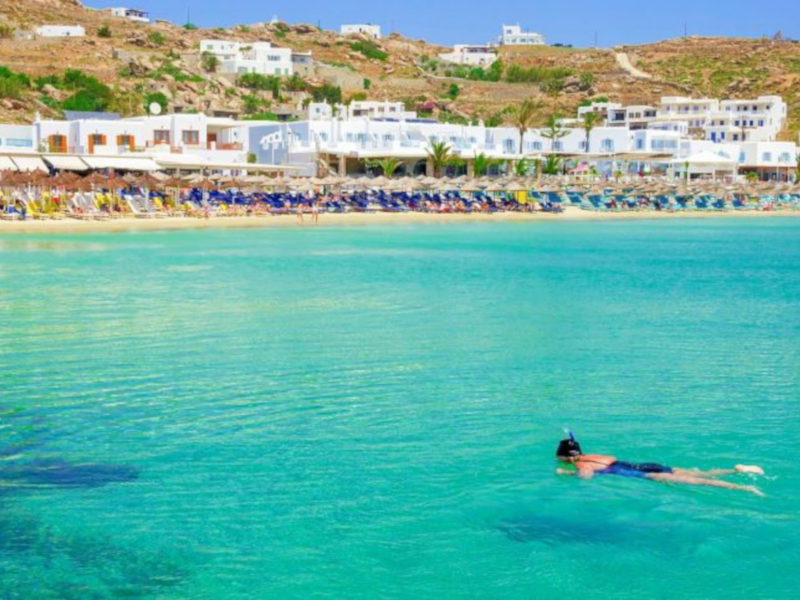Mykonos
Welcome to Greece’s most famous cosmopolitan island, a whitewashed paradise in the heart of the Cyclades. According to mythology, Mykonos was formed from the petrified bodies of giants killed by Hercules. The island is part of the Cyclades, lying between Tinos, Syros, Paros and Naxos.
Mykonos’s nickname is “The Island of the Winds” .
Mykonos Island Sightseeing
Little Venice
One of the most scenic corners of the island is “Little Venice”, an 18th century district, dominated by grand captains’ mansions with colourful balconies and stylish windows. The balconies perched over the sea, pictures of the famous Italian city spring to mind. Little Venice is a popular spot with vivid nightlife and lovely cafeterias.
Windmills
Mykonos’ other main attraction is its Windmills, which stand facing the sea and at night are beautifully lit up. Powered by the north wind, they used to ground grain into flour until the early 20th century.
Petros the Pelican
While you’re out strolling, don’t be surprised if you come across the official mascot of Mykonos, which is nothing other than a… pelican! Pétros the Pelican was found and took care by a fisherman after a storm in 1954, but surprisingly he didn’t leave when he was cured but made Mykonos his home. When he died, the grief for his loss was so deep that a replacement was soon found.
So, whatever you do, don’t forget to take a picture with the successor of the famous pelican Pétros!
Delos
Although one of the smallest Aegean islands (6.85 sq. Km.), in the ancient times was the most famous and most sacred of all the islands because, according to myth, it was the birthplace of Apollo and Artemis. Zeus then created a circle of islands around Delos as a tribute to his children. Today Delos belongs to the Municipality of Mykonos. The island has a small port, where small boats bring visitors to the archaeological site.
Mykonos Museums & Churches
Museums
Mykonos is a beautiful place of major historical interest that is well-preserved to this day. A visit to the museums of the island is highly recommended .
Archaeological Museum
The archaeological museum of Mykonos includes findings from excavations on the island and the surrounding small islets, such as small statues, ceramic vases, and jewelry. Here visitors will enjoy a vast collection of exhibits from the Hellenistic period and prehistoric times including vessels, statues, and columns.
The Archaeological Museum of Delos
The museum was built way back in the year 1904. Initially, the museum was spread over just five rooms. It was much later in the year 1931 and again in 1972 that further rooms were added. At present the historical artifacts are on display in nine rooms. There are six exclusive rooms where rare historical statues unearthed from the archaeological site at Delos are on display.The archaeological museum of Delos hosts findings from excavations on this sacred island, such as the famous lion statues, marble busts, and golden jewelry.
Churches
The picturesque churches is one of the islands most popular characteristics. It is said that they were so many small churches on the island as the many days of the year. You see them everywhere, so don’t miss to visit some of them. Most churches of Mykonos have a simple construction, with the characteristic red-brick color to the outside of the roofs. Some are very old but the majority of them dated to the 17th, 18th and 19th century.
Here are some of the churches that you must visit:
Panagia Paraportiani
It is a popular destination as this unique complex of five churches, four of which are on the ground and the fifth on the roof, has become known as an iconic symbol of the island of Mykonos.
Panagia Rodario
Located in Chora, the Catholic Church of Panagia Rodario works for the needs of the local Catholics and tourists. It is near the windmills of Mykonos. Although it was destroyed in a fire in 1991, it was repaired a few years later.
Paleokastro Monastery
Τhis convent is located in one of the island’s rare green spots, along a hill outside of Ano Mera. It’s known for its classical Cycladic architectural style, dating from the late 18th century. This monastery still works as a nunnery.
Mykonos Traditional Products
Don’t miss the opportunity to treat yourself to some local Aegean specialties!
Pepper flavoured kopanistí, a soft cheese seasoned with pepper, is the island’s gastronomic trademark. Try it as a topping on a round rusk spread with grated tomato, a favourite local mezés (appetiser).
Meat eaters can sample “loúzes” (cooked pork filet with spices) and tasty local sausages sprinkled with pepper, and local oregano that has been caressed by the sun and dried in the north wind.
To finish off your meal you can sample two exceptionally good local pastries, “amigdalotá” (small round cakes with ground almond, rosewater and caster sugar) and honey pie.
Mykonos Folklore Festivals and Cultural Events
Of particular interest are the feasts and festivals of the island. The great feasts of Christianity honored with pomp and revive traditions of the past. Also events that held in Mykonos, vary each year. Very popular are those organized at the Municipal Art Gallery.Don’t forget the annual gay festival taking place in different places each time. Most festivals are accompanied by tasty food and dancing.
The most famous are :
Religious Feasts & Festivals
August 15th
On the 15th of August, a great feast takes place in the village of Ano Mera, at the church of Panagia Tourliani.
July 26th
On the 26th of July is the celebration of Agia Paraskevi.
June 30th
On the 30th of June is a feast dedicated to Agioi Apostoloi.
Cultural Events
Mykonos Summer Festival
Mykonos is synonymous to wild parties and lively atmosphere and has the unique privilege to organize a set of exciting events including open-air concerts, theatrical performances, and various art exhibitions. Artists from all around the world take part in the famous Mykonos Summer Festival.
Gay Festival
The annual Gay Festival is a special event in Mykonos where thousands of gay visitors arrive from every part of the world.
Harvest Festival
On the windy island of Mykonos, in the middle of September, you will have the chance to enjoy the Harvest Festival, which is held annually at the Agricultural Museum.
Mykonos Beaches
Mykonos beaches are famous all over the world for their golden sand and crystal waters. As this is among the most popular tourist destinations in Greece, most Mykonos beaches are organized with many tourist facilities, from seaside accommodation to beach bars, restaurants, and water sports centers.
The best-organized beaches in Mykonos are found on the southern coast, which gets extremely overcrowded during peak season. Beaches on the northern coast of the island are less organized and ideal to enjoy some calm moments. Nudism is frequently practiced there.
The most famous beaches are :
Super Paradise
Super Paradise is right next to Paradise Beach. It is one of the most famous beaches of Mykonos attracting mostly young people for the famous day and night beach parties. The place where all 20-somethings want to be at. . It can be full of people but it’s worth !!
Paradise
It has thick sand, crystal clear waters and is organized with beach-bars with swimming pools where many parties and celebrations are held all summer. You can do water sports and have a diving center.
Kalo Livadi
Although Kalo Livadi is far from Chora, this is an organized beach with many umbrellas and sun beds.
Platys Gialos
Quite beautiful and with crystal-clear waters, this is also a convenient starting point to discover other beaches, on a water taxi.
Psarou
There’s a reason why this is currently the island’s trendiest beach — it’s great for swimming and offers a beautiful scenery.
Panormos
A former hidden secret, remains largely wild and perfect for naturists.
-
Destination
Tour Location


